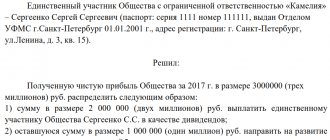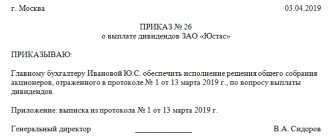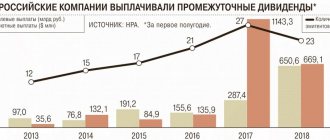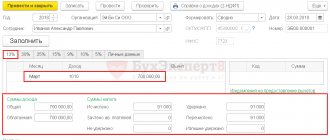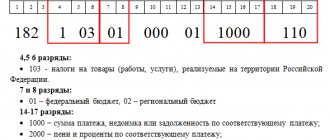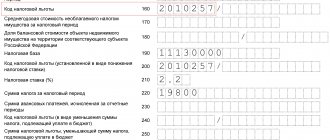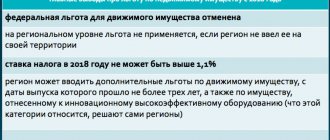The concept of dividends and payment terms
The concept of dividends is most fully defined in Art. Tax Code of the Russian Federation. The Code classifies as dividends any income received by a shareholder or participant when distributing profits.
However, the presence of net profit alone is not enough to accrue dividends. It is also necessary to take into account the rules established by Art. Law of December 26, 1995 No. 208-FZ “On JSC” and Art. Law of 02/08/1998 No. 14-FZ “On LLC”. The following restrictions are common to both main organizational and legal forms:
- full payment of the authorized capital must be made;
- net assets must be greater than the sum of the authorized capital and reserve funds, and this condition must be met even after the payment of dividends;
- the company should not have signs of bankruptcy, both at the time of making the decision to pay dividends and after their payment.
In addition to the general ones, there are also “specific” restrictions related to the characteristics of specific types of business entities.
For an LLC, a decision to pay dividends cannot be made until the value of the retiring participant's share has been paid.
The founders of a joint-stock company cannot begin the procedure for paying dividends if all the shares in respect of which they have the right to demand redemption have not been purchased from the shareholders.
Also, joint-stock companies must observe the order of payments depending on the category of shares - first preferred ones, which have advantages, then “ordinary” preferred ones, and then ordinary ones.
NTVP "Kedr - Consultant"
LLC "NTVP "Kedr - Consultant" » Services » Consultations on accounting and taxation » Other tax issues » Is it possible to receive dividends for previous years (2017 and 2021) from retained earnings in January 2021?
The director really needs to receive dividends
Question
Is it possible to receive dividends in 2021 from retained earnings in previous years (2017, 2021)
Expert's answer
LLCs and JSCs may pay dividends if, in particular, the following conditions are met <1>:
— the value of the company’s net assets is greater than its authorized capital and reserve fund and will remain so after the payment of dividends (therefore, it is necessary to form a balance sheet and calculate net assets both on the date of adoption of the “dividend” decision and on each date of payment of dividends);
— the company has no signs of bankruptcy and they will not appear due to the payment of dividends (that is, there should not be debt in the amount of more than 300 thousand rubles with a delay of more than 3 months);
— the authorized capital of the company is fully paid;
- participants who left the company were paid the actual value of their share, and shareholders were paid the redemption value of their shares.
If these conditions are not met, there is a risk that, during an inspection, the Federal Tax Service will reclassify dividends as other paid income and calculate taxes on it at general tax rates (for more details, see the journal “General Ledger”, 2021, No. 8, p. 11).
<1> Article 29 of the Law of 02/08/1998 N 14-FZ; pp. 1, 4 tbsp. 43 of the Law of December 26, 1995 N 208-FZ.
{Article: When LLCs and JSCs can pay dividends (“General Ledger”, 2021, N 6) {ConsultantPlus}}
At the same time, if the profit of previous years was not directed anywhere and accumulated, then the general meeting of participants can use it to pay dividends. That is, they can decide to pay dividends not only based on the net profit of the reporting year, but also on the profits of previous years. Neither tax nor civil legislation prohibits this (clause 1 of the Letter of the Federal Tax Service of Russia dated 05.10.2011 N ED-4-3/ [email protected] , Letter of the Ministry of Finance of Russia dated 20.03.2012 N 03-03-06/1/133, dated 04/06/2010 N 03-03-06/1/235, Resolution of the Presidium of the Supreme Arbitration Court of the Russian Federation dated 06/25/2013 N 18087/12).
In accordance with paragraph 1 of Art. 28 of Federal Law No. 14-FZ “On Limited Liability Companies” and paragraph 1 of Art. 42 of Federal Law N 208-FZ “On Joint Stock Companies”, participants can make decisions on the payment of dividends from the net profit of the reporting year based on the results of a quarter, half a year, 9 months or based on the results of a calendar year. The above rules do not apply to profits from previous years. Consequently, participants can decide on its distribution at any time and with any frequency.
Article: It's accumulated! (Ezhova O.) (“Calculation”, 2014, N {ConsultantPlus}
(Ezhova O.) (“Calculation”, 2014, N {ConsultantPlus}
Payment of dividends to company participants from the profits of previous years is carried out in the same manner as in the case of their payment from profits received in the current year.
{Question: Does an LLC have the right to pay dividends from the profits of previous years? (Expert Consultation, 2019) {ConsultantPlus}}
Drawing a conclusion from the above, we understand that it is possible to pay dividends for previous years. The main thing is that all conditions for the payment of dividends are met.
The explanation was given by the accountant-consultant of LLC NTVP "Kedr-Consultant" Natalya Borisovna Petrova in February 2019.
When preparing the answer, SPS ConsultantPlus was used.
This clarification is not official and does not entail legal consequences; it is provided in accordance with the Regulations of the CONSULTATION LINE ().
Dividend calculation
The calculation of dividends in a joint-stock company is carried out in several stages.
First of all, the total amount that the company can allocate for payment is determined, taking into account the conditions listed in the previous section and the recommendations of the Board of Directors.
First, the amount to be paid on preferred shares is determined. They pay a fixed dividend - this is the amount specified in the company's charter for each type of such shares. This can be a percentage of the par value of the stock or a fixed amount of money:
- Dp = Kp1 x Dp1 + Kp2 x Dp2 + ... + Kpi x Dpi, where Kp1 ... Kpi is the number of preferred shares of each type
- Dp1 ... Dpi - the amount of dividends per type of share
Next, the remaining portion of the allocated funds is distributed among the holders of ordinary shares. How to calculate dividends per 1 ordinary share can be seen from the formula:
- To = (D – Dp) / Ko, where D is the total amount allocated by the company for the payment of dividends
- Ko - number of ordinary shares
In LLC everything is much simpler. How dividends are calculated in this case depends only on the distribution of shares between participants. The formula shows how to calculate dividends per founder:
- Di = D x DLi, where D is the total amount of distributed profit
- DLi - participant’s share in the authorized capital of the company
Let's look at an example of calculating dividends for a joint stock company.
The authorized capital of the company is 1 million rubles. and divided into 1000 shares with a par value of 1 thousand rubles. Of these, 200 pcs. are privileged, and 800 pcs. – ordinary. Based on the results of the year, a decision was made to pay dividends in the amount of 120 thousand rubles. According to the charter, dividends in the amount of 20% of the par value must be paid for each preferred share.
Payments on preferred shares will be:
- Dp = 200 pcs. x (20% x 1000 rub.) = 200 pcs. x 200 rub. = 40,000 rub.
Payment amount per one ordinary share:
- Up to = (120 tr. - 40 tr.) / 800 pcs. = 80 t.r. / 800 pcs. = 100 rub.
The dividend rate is the ratio of the annual payment to the par value (or current market price) of the stock. In this case, for preferred shares it will be 20%, and for ordinary shares – 10%.
Nuances
It is important to consider the following limiting factors:
Firstly, the company’s charter must indicate the types of property (movable, immovable, including securities) that can be transferred for the payment of dividends (clause 1, article 42 of the Law “On JSC”, clause 3, article 28 of the Law “ About LLC").
Secondly, when paying dividends with property to an individual participant, a situation may arise in which the organization will not be able to withhold personal income tax - this will happen if the participant does not receive any income from the organization other than dividends. In this case, the company must submit a notification to the Federal Tax Service about the impossibility of such deduction, and the individual will be required to independently pay personal income tax by July 15 of the next year.
Thirdly, if we are talking about the payment of dividends with property, then one should take into account the position of the Ministry of Finance and tax authorities that in this case there is a sale and, accordingly, the obligation to pay VAT and income tax (single tax under the simplified tax system).
Procedure and terms of payment of dividends
Dividends in 2021 are paid based on the decision of the general meeting of shareholders (participants).
Many business owners are interested in whether it is possible to pay dividends in installments. The law allows you to do this once every quarter, half year or year. Because net profit is finally determined only at the end of the year, then quarterly and semi-annual payments are interim dividends.
The dividend payment date is tied to the date of the decision of the general meeting. For a joint stock company, the “cut-off” day is first determined, i.e. the date on which the list of persons entitled to receive them is recorded. The cutoff for dividends for 2021 should be set no earlier than 10 and no later than 20 days after the decision on payment is made (clause 5 of Article 42 of Law No. 208-FZ). The actual payment of dividends must be made within 10 days from the cut-off date - to nominee holders and trustees, and within 25 days - to all other shareholders.
For an LLC, the period for paying dividends should not exceed 60 days from the date of the decision (Clause 3, Article 28 of Law No. 14-FZ). The charter or minutes of the meeting of participants may provide for a shorter period. If it is not specified, then “by default” dividends must be issued within the 60-day period established by law.
The method of payment of dividends does not depend on the form of the legal entity. This may be the issuance of funds (both cash and non-cash) or the transfer of property.
When paying dividends, the company performs the functions of a tax agent for income tax or personal income tax, depending on the category of the income recipient.
For individuals, the personal income tax rate is 13% for residents (in the 2-NDFL certificate, the dividend income code is 1010) and 15% for non-residents (Article 224 of the Tax Code of the Russian Federation). The same rates (13% and 15%), depending on the resident status, are applied to income tax for legal entities (clause 3 of Article 284 of the Tax Code of the Russian Federation).
If the organization receiving the dividends owns over 50% of the authorized capital of the payer for a year or more, then a preferential rate of 0% is applied.
In this case, taxes are calculated taking into account whether the payer company, in turn, is the recipient of dividends. In this case, for dividend tax, the calculation formula is as follows:
- Н = К x Сн x (Д1 – Д2) К – share of dividends attributable to a specific recipient;
- Сн - tax rate on dividends
- D1 – total amount of dividends
- D2 - dividends received by the organization in the past or previous periods and not previously used to calculate taxes.
The above formula does not apply to payments in favor of non-residents. For them, the tax is calculated based on the total amount of dividends paid by the company (clause 6 of Article 275 of the Tax Code of the Russian Federation)
Rules for payment of interim dividends
Interim dividend streams must be paid with certain rules. These rules may be legal, accounting, or tax in nature.
Next, I will tell you about all the stages and possible problems of this process in more detail.
Normative base
The main document regulating the procedure for calculating and distributing profits is Federal Law 208 “On Joint-Stock Companies”
Also one of the regulating legislative acts is the Tax Code of the Russian Federation. The very concept of dividend flows, from the point of view of tax characteristics, is described in Article 224.
The legal basis for the distribution of income among shareholders is described in Article 103 of the Civil Code of the Russian Federation.
I would also like to note an important point that, by law, a decision on an interim payment of funds to shareholders must be made within 3 months after the end of the period for which the payment will be accrued.
How is cash issued
Cash issuance is carried out through a non-cash transfer to a bank account, the details of which are contained in the registrar’s information database. If the registration authorities do not have such data, money can be paid through a postal transfer to the shareholder’s registration address.
Accounting entries
When the calculation base for paid funds is the state of emergency of a joint stock company, accounting entries for accruing income to the founders pass through “Debit 84” and “Credit 75, subaccount (Calculations for payment of income).”
If there is a loss at the end of the year
As I said earlier, interim divas can be paid despite the fact that there is a possibility of a loss occurring throughout the year.
In this case, after recording losses in accounting, it is necessary to reflect the distributed funds as an accrual of gratuitous payments to shareholders through the accounts “Debit 91-2” and “Credit 76”.
How to be a simplifier
If an organization is on a simplified taxation system and is interested in the possibility of distributing profits through dividend flows, then the main mandatory criterion will be maintaining complete accounting records for all operations. Without appropriate documentary evidence of all cash flows, amounts cannot be paid.
Closing the registry
The register closing date reflects the specific point in time at which the final list of shareholders claiming to distribute profits for a certain period is recorded.
Those. To receive dividends, you must be the owner of the shares on the closing date of the register.
It is important to remember that trading on the Moscow Exchange takes place in T+2 mode. This means that the shareholder fixes his rights only after 2 trading sessions; therefore, in order to receive payments, he needs to purchase securities two business days before the closing date of the shareholder register.
Position of the courts
Back in 2011, landmark judicial acts were adopted in the case of Farmland CJSC. Three courts, including the Federal Antimonopoly Service of the Ural District (Resolution No. F09-1246/11-S2 dated May 23, 2011), supported the taxpayer in a dispute with the tax authority on the issue of calculating VAT and income tax when paying dividends with real estate. The courts have indicated that the payment of dividends in real estate is not the sale of this property, but forms an object of taxation under the personal income tax.
The courts have indicated the following as necessary conditions for the payment of dividends with property:
- Indication in the company's charter on the possibility of paying dividends with property.
- Availability of retained earnings after tax.
In the Resolution dated 02.25.2015 in case No. A58-341/2014, the Arbitration Court of the East Siberian District spoke in a similar way: “Since the legislation allows the payment of dividends to a shareholder with real estate, the transfer of this property does not form an object of taxation other than income, therefore, it is not sale of real estate subject to VAT.”
The same position was indirectly confirmed by the Supreme Court of the Russian Federation in Ruling No. 302-KG15-6042 dated July 31, 2015, refusing to transfer the case for review and indicating that the transfer of real estate for the payment of dividends is not included in the VAT tax base.
Since the tax authorities continue to insist on their position, the use of this method of transferring property to a company participant is associated with the risk of tax claims, which will have to be resolved at the level of the arbitration court. Although, as our experience shows, territorial tax authorities reluctantly listen to the taxpayer’s arguments and judicial practice within the framework of a constructive dialogue, without regarding such a transfer as an implementation.
Source:
Center for business structuring and tax security taxCOACH
Heading:
Taxes, fees, duties
dividends taxes personal income tax VAT
Sign up 6825
9750 ₽
–30%
